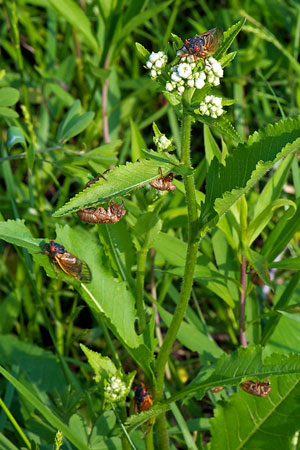Some cicadas stop to sniff the flowers
Flora Columnist
As described in last week’s Citizen, the media is abuzz with the sounds and sights of the 13-year cicada.
Members of Duke Garden’s spring flora class must be among the first to have spotted the early emerging members of this now famous Brood XIX. Three weeks ago, the class was exploring the flora of Penny’s Bend Nature Preserve to view some of the rare Piedmont prairie species. The glade wild quinine, Parthenium auriculatum, and eastern prairie wild blue indigo, Baptisia australis var. aberrans, were just beginning to peak. If you visit there in the next few days, you’ll most likely catch some still in flower.
The class was surprised to find these engaging red-eyed cicadas already there scattered throughout the low prairie vegetation. They were not yet in the trees of the adjacent forests, but, rather, seemed to be soaking up the sunshine while perched atop both the white-flowered quinine and the blue-flowered indigo.
They had emerged from the ground the evening before and climbed up the nearest vegetation – that being rare wildflower species – to shed their outside skeletons under cover of darkness. The cicadas were quite content to let folks get up close and even touch them. The adults require four to six days to fully mature before they begin several weeks of boisterous mating behavior in the treetops high above.
There is no concern that the rare quinine and indigo plants will be harmed by the visiting cicadas. For the most part, they are harmless to vegetation, even to the trees on which they feed and deposit their eggs. That will be particularly difficult to appreciate when we become alarmed at the sight of brown tree canopies in another week or so.
In those numerous, though isolated, areas where hundreds and thousands of cicadas have emerged, large deciduous trees, primarily oaks, will be littered with hanging peripheral twigs of brown foliage. The branch tips break and frequently fall to the ground because the female cicada has nibbled the twigs for nourishment and cut numerous slits to deposit eggs.
Healthy mature trees and shrubs will manage to survive this infrequent cicada occurrence. Serious harm may, however, result if cicadas choose recently planted ornamental trees and shrubs and fruit crops. You can protect smallish specimens by covering them with netting for the next several weeks. And, looking ahead, you can plan not to plant such cherished woody plants during years of anticipated large-scale cicada appearances.
Now, that’s easier said than done, isn’t it?
You’ll find lots of fascinating information on all the cicadas at magicicada.org. With a little browsing, you’ll learn not to plant tender young trees and shrubs in Rockingham and Yadkin counties in 2013 and definitely not in the Asheville environs in 2017, because broods of 17-year cicadas are scheduled to arrive then.
So for now, simply enjoy observing and learning more about another phenomenon of nature over which we have little influence.
Email Ken Moore at flora@carrborocitizen.com.
Find previous Ken Moore Citizen columns at The Annotated Flora.





Comments are closed.